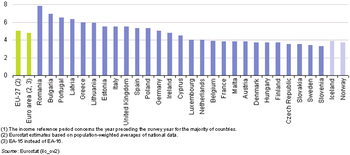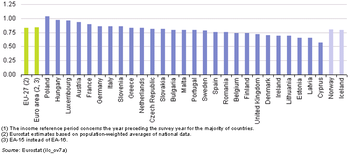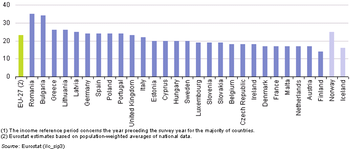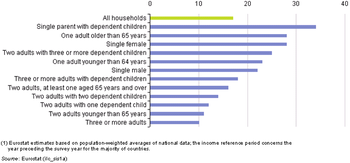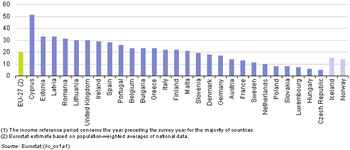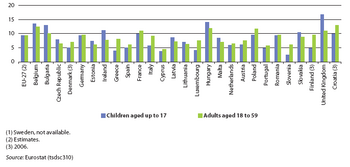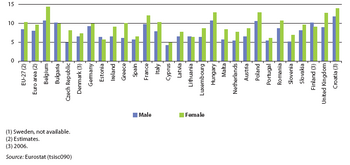Archive:Income poverty statistics
- Data from September 2008, most recent data: Further Eurostat information, Main tables and Database.
Favourable living conditions depend on a wide range of factors, which may be divided into those that are income-related and those that are not. The latter includes quality healthcare services, education and training opportunities or good transport facilities – aspects that affect everyday lives and livelihoods. The income distribution within a country provides a picture of inequalities. This article analyzes recent statistics on living conditions in the European Union (EU).
Main statistical findings
Societies cannot combat poverty and social exclusion without analysing inequalities within society, whether they are economic in nature or social. Data on economic inequality becomes particularly important for estimating relative poverty, because the distribution of economic resources may have a direct bearing on the extent and depth of poverty.
There were wide inequalities in the distribution of income among the population of the EU-27 in 2007; the 20 % of the population with the highest equivalized disposable income received five times as much income as the 20 % of the population with the lowest equivalised disposable income. This ratio varied considerably across the Member States, from 3.3 in Slovenia and 3.4 in Sweden, through 6.0 or more in Greece, Latvia and Portugal, to highs of 6.9 in Bulgaria and 7.8 in Romania. Relatively wide income inequalities were not confined to those countries with relatively low GDP per capita, as the distribution of income (using this measure) was noticeably more equitable in Slovakia and the Czech Republic, by way of example, than it was in the United Kingdom and Italy.
Social protection measures can be used as a means for reducing poverty and social exclusion. This may be achieved, for example, through the distribution of (means-tested) benefits. One way of evaluating the success of social protection measures is to compare at-risk-of-poverty indicators before and after social transfers.
In 2007, social transfers reduced the at-risk-of-poverty rate among the population of the EU-27 from 26 % before transfers to 17 % after transfers, thereby lifting 35 % of those in poverty above the poverty line. The impact of social benefits was lowest in Bulgaria and a number of the Mediterranean Member States (Greece, Spain, Italy and Cyprus) in 2007. In contrast, one half or more of those persons who were at-risk-of poverty in Sweden, Hungary, Denmark, Finland, the Netherlands, Austria, the Czech Republic and France were removed as a result of social transfers.
Ageing population
There is policy interest in the inequalities felt by many different groups in society: one group of particular interest is that of the elderly, in part reflecting the growing proportion of the EU’s population aged over 65 years. Pension systems can play an important role in addressing poverty amongst the elderly. In this respect, it is interesting to compare the incomes of the elderly with the rest of the population.
Poland was the only Member State where the median equivalised disposable income of the elderly was similar or slightly higher than it was for persons under 65; in France, Austria, Luxembourg, and Hungary, the median income of the elderly was more than 90 % of that recorded for people under 65. In contrast, the elderly in Cyprus had a median income that was around 57 % of that recorded for people under 65, with shares between 65 % and 70 % in Ireland, Lithuania, Estonia, Latvia and Denmark. These relatively low proportions may broadly reflect pension entitlements, as well as fast economic growth through to 2007, which mainly benefited people of an active age.
The depth of poverty, which helps to quantify just how poor the poor are, can be measured by the relative median at-risk-of poverty gap. The median income of persons at risk-of-poverty in the EU-27 was an average 23 % below the 60 % poverty threshold in 2007. Among the Member States, the national at-risk-of-poverty gap was widest in Romania and Bulgaria in 2007, but also relatively wide in Greece, Lithuania and Latvia; this gap was narrowest in Finland.
Other at-risk groups
The elderly and retired were not the only group living at risk of poverty in 2006. Across the population of the EU-25, an estimated 15 % of people aged 18 or older lived under the shadow of poverty, even after social transfers. The most vulnerable group were the unemployed (self-assessed most frequent activity status), about two-fifths (41 %) of whom were at risk of poverty, a share that rose to around 60 % in each of the Baltic Member States. Nearly a third (32 %) of single-parent households with dependent children were at risk of poverty across the EU-25 in 2006 - the highest proportion of any type of household covered by the survey. In contrast, multi-adult households without dependent children tended to be the households with the least risk of poverty. (Please note that the at-risk-of-poverty rate emphasizes a relative concept of income poverty, proportional to the level of income in one country, and does not take into account wealth or actual purchasing power; it also assumes that household members share their resources. Additionally, it is influenced by the equivalence scale chosen. In the future, the at-risk-of-poverty rate will be complemented by other poverty indicators.)
In 2007, some 9.3 % of the EU’s population aged between 18 and 59 lived in a jobless household; the proportion of children (up to 17 years of age) living in jobless households was almost at the same level (9.4 %). The highest proportion of children living in jobless households was recorded in the United Kingdom (16.7 %), followed by Hungary (14.0 %) and Belgium (13.5 %); these two Member States also recorded the highest shares of adults aged 18 to 59 years old living in jobless households, along with Poland. Note that these statistics may be affected by a number of factors, including differences in average numbers of children and inactivity rates between different socio-economic groups.
Data sources and availability
Eurostat's statistical indicators within the income and living conditions domain cover a range of topics relating to income poverty and social exclusion. One group of indicators relate to monetary poverty analyzed in various ways (for example, by age, gender and activity status), across space and over time. Another set relate to non-monetary poverty and social exclusion (for example, material deprivation, social participation) across space and over time. A newly developed set of child-care arrangement indicators complements the information in this domain.
EU-SILC is now Eurostat’s main reference source for comparative income distribution and social exclusion statistics. It comprises both a cross-sectional dimension and a longitudinal dimension. From 2005, EU-SILC covered the 25 Member States, as well as Norway and Iceland; Bulgaria, Romania, Turkey and Switzerland launched EU-SILC in 2007.
The relative median income ratio is defined as the ratio of the median equivalized disposable income of people aged above 65 to the median equivalized disposable income of those aged below 65.
The at-risk-of-poverty rate is defined as the share of people with an equivalized disposable income that is below the at-risk-of-poverty threshold, set at 60 % of the national median equivalized disposable income. This rate may be expressed before or after social transfers, with the difference measuring the hypothetical impact of national social transfers in reducing poverty risk. Retirement and survivors' pensions are counted as income before transfers and not as social transfers. Various breakdowns of this indicator are calculated: by age, gender, activity status, household type, education level, etc. It should be noted that this indicator does not measure wealth but low current income (in comparison with other people in the same country) which does not necessarily imply a low standard of living.
The relative median at-risk-of-poverty gap is calculated as the difference between the median equivalised disposable income of people below the at-risk-of-poverty threshold and the at-risk-of-poverty threshold, expressed as a percentage of the at-risk-of-poverty threshold (cut-off point: 60 % of median equivalised income). The EU aggregate is a population weighted average of individual national figures. In line with decisions of the European Council, the at-risk-of-poverty rate is measured relative to the situation in each country rather than applying a common threshold to all countries.
Material deprivation, covers an economic strain and a durables strain, defined as the enforced inability (rather than the choice of not being able/having) to pay for at least three of the following nine items: unexpected expenses; one week annual holiday away from home; arrears (mortgage or rent payments, utility bills, or hire purchase instalments or other loan payments); a meal with meat or fish every other day; heating to keep the home adequately warm; a washing machine; a colour television; a telephone; or a car.
The indicators related to jobless households (the share of children aged 0-17 and the share of adults aged 18-59 who are living in households where no one works) are calculated as the proportion of people of the specified age who live in households where no one is working. Students aged 18 to 24 who live in households composed solely of students of the same age class are counted neither in the numerator nor the denominator of the ratio; the data comes from the EU Labour force survey (LFS).
Context
Analysis of the distribution of incomes within a country provides a picture of inequalities. On the one hand, inequalities may create incentives for people to improve their situation through work, innovation or acquiring new skills, while on the other hand, crime, poverty and social exclusion are often linked to inequalities in income distribution.
Further Eurostat information
Publications
- 79 million EU citizens were at-risk-of-poverty in 2007, of whom 32 million were also materially deprived - Statistics in focus 46/2009
- The social situation in the European Union 2005-2006
- The life of women and men in Europe – A statistical portrait
- Living conditions in Europe - Statistical pocketbook - Data 2002-2005
Main tables
- Income and living conditions (t_ilc)
- Income distribution and monetary poverty (t_ilc_ip)
- At-risk-of-poverty rate after social transfers by gender (tsisc030)
- At-risk-of-poverty rate, by age group (tsdsc230)
- At-risk-of-poverty rate, by household type (tsdsc240)
- At-risk-of-poverty rate of elderly people (tsdde320)
- In work at-risk-of-poverty rate (tsdsc320)
- At-risk-of-poverty-rate, by highest level of education attained (tsdsc420)
- At-risk-of-poverty rate before social transfers by gender (tsisc020)
- Relative median at-risk-of-poverty gap (tsdsc250)
- Inequality of income distribution (tsisc010)
- Income distribution and monetary poverty (t_ilc_ip)
Database
- Income and living conditions (ilc)
- Income distribution and monetary poverty (ilc_ip)
- Monetary poverty (ilc_li)
- At risk of poverty thresholds (ilc_li01)
- At risk of poverty rates by age and gender (ilc_li02)
- At risk of poverty rates by household type (ilc_li03)
- At risk of poverty rates by most frequent activity in the previous year (persons over 16 years) (ilc_li04)
- At risk of poverty rates by main source of income (ilc_li05)
- At risk of poverty rates by work intensity of the household (ilc_li06)
- At risk of poverty rates by education level (ilc_li07)
- At risk of poverty rates by tenure status (ilc_li08)
- At risk of poverty rates before social transfers (pensions included in social transfers) (ilc_li09)
- At risk of poverty rates before social transfers (pensions excluded from social transfers) (ilc_li10)
- Relative at risk of poverty gaps (ilc_li11)
- At risk of poverty rates anchored at a point in time by gender and age (ilc_li20)
- At persistent risk of poverty rates by gender and age (ilc_li21)
- At-risk-of-poverty rate anchored at a fixed moment in time (2005) by age and gender (ilc_li22)
- Distribution of income (ilc_di)
- Distribution of income by quantiles (ilc_di01)
- Distribution of income by different income groups (ilc_di02)
- Mean and median income by age and gender (ilc_di03)
- Mean and median income by household type (ilc_di04)
- Mean and median income by most frequent activity status (ilc_di05)
- Mean and median income by main source of income (ilc_di06)
- Mean and median income by work intensity of the household (ilc_di07)
- Mean and median income by education level (ilc_di08)
- Mean and median income by accommodation tenure status (ilc_di09)
- Mean and median income by ability to make ends meet (ilc_di10)
- S80/S20 income quintile share ratio by gender and selected age group (ilc_di11)
- Gini coefficient (ilc_di12)
- In-work poverty (ilc_iw)
- In-work at risk of poverty rates by age and gender (ilc_iw01)
- In-work at risk of poverty rates by household type (ilc_iw02)
- In-work at risk of poverty rates by work intensity of the household (ilc_iw03)
- In-work at risk of poverty rates by education level (ilc_iw04)
- In-work at risk of poverty rates by type of contract (ilc_iw05)
- In-work at risk of poverty rates by months worked (ilc_iw06)
- In-work at risk of poverty rates by full-/part-time work (ilc_iw07)
- Monetary poverty (ilc_li)
- Income distribution and monetary poverty (ilc_ip)
Dedicated section
Other information
External links
- OECD statistics - Income distribution - Inequality (country-by-country comparisons)
